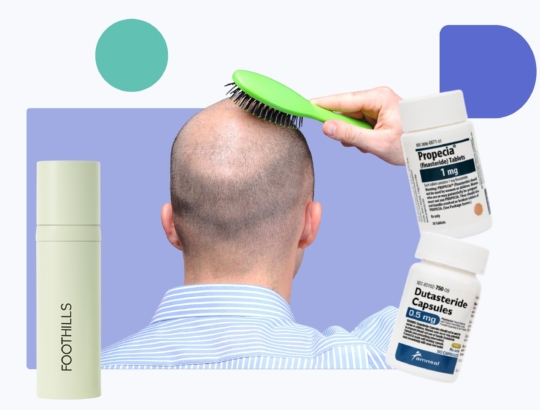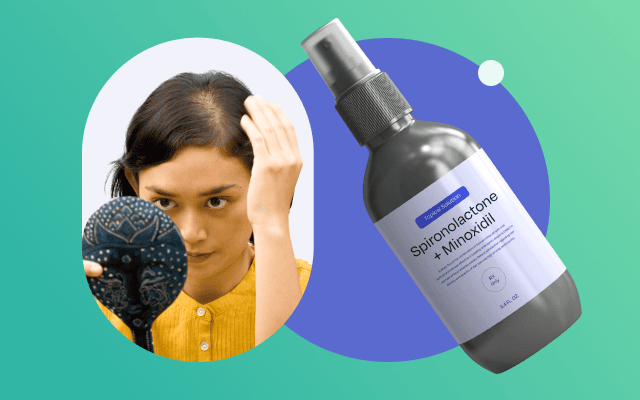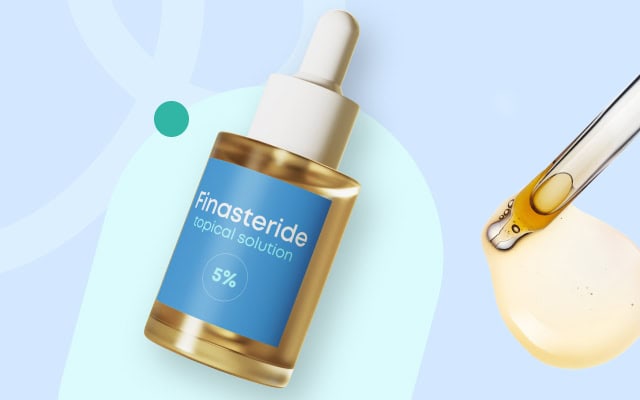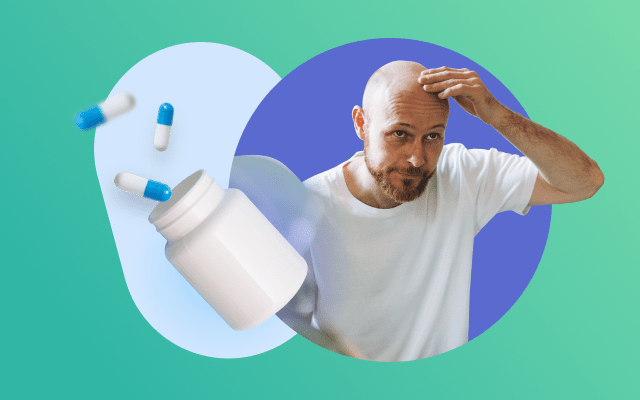Understanding compounded topical finasteride
Dr. Eric Howell, board-certified dermatologist, talks about the off-label use of topical finasteride in the treatment of male pattern baldness.
Table of Content:
What is topical finasteride? | How to get a prescription? | Side effects | How to apply it? | Additional tips | FAQs
Our commitment to producing high-quality content:
The information presented in this article is based on scientific research and the professional advice of our Content Medical Reviewers, who are experts in the field of Dermatology. How we write our content →
What is topical finasteride?
Dr. Eric Howell, board-certified dermatologist says that topical finasteride is a compounded preparation that contains the active pharmaceutical ingredient finasteride in a topical form. It is sometimes prescribed by dermatologists off-label for use on the scalp.
Important disclaimer: Compounded medications, including topical finasteride, are not reviewed or approved by the U.S. Food and Drug Administration (FDA) for safety or effectiveness.
Is topical finasteride FDA-approved for hair loss?
No. There are no FDA-approved topical finasteride products. Any topical finasteride available to patients is a compounded preparation made by a pharmacy pursuant to a prescription.
Some healthcare providers may discuss published research on finasteride in different forms, but it is important to understand that compounded topical finasteride has not been reviewed by the FDA for safety or effectiveness.
Patients considering compounded topical finasteride should consult with a licensed healthcare provider to discuss potential risks, uncertainties, and alternative options.
Do you need a prescription for a topical finasteride?
Yes. A prescription from a licensed healthcare provider is required for compounded topical finasteride. The decision to prescribe depends on the provider’s medical judgment and an evaluation of the patient’s needs.
How to get an online prescription via Miiskin?
Miiskin connects you with board-certified dermatologists, who may prescribe FDA-approved generics or personalized compounded medications.
If you are interested in a customized formula, simply select Foothills as your pharmacy and place your medication order directly in the Miiskin platform. Foothills will send you a payment link, and once payment is completed, your medication will be shipped free via UPS 2-day delivery.
Transparent pricing: A consultation is typically around $59, and medication refills are around $39. The price of most Foothills formulas via Miiskin is $48.99 with a few exceptions being priced at $58.99 and some hair growth formulas priced at $68.99. You will not be enrolled in an automatic subscription, you will only purchase medication when you need it.
Important Disclaimer: Compounded medications are not reviewed by the FDA for safety or efficacy.
Possible risks and considerations
Because topical finasteride is not FDA-approved, its safety and effectiveness have not been established. Healthcare providers may discuss possible risks and considerations with patients, including:
- Local scalp irritation (e.g., redness, itching, dryness).
- Theoretical risk of systemic side effects since finasteride is absorbed in small amounts through the skin.
- Not recommended for individuals who are pregnant, may become pregnant, or are breastfeeding.
Patients should always inform their healthcare provider of their medical history, current medications, and family planning intentions before starting treatment.
How to use topical finasteride?
Dr. Howell says that you should always follow the instructions provided with the medication and your doctor. However, as a general rule, here are some guidelines.
Wash and towel dry your scalp
Before applying topical finasteride, ensure your scalp is clean and dry. Wash your hair and scalp with a mild shampoo and dry your hair and scalp with a towel.
Apply evenly
Part your hair to expose the scalp and apply the measured dose evenly across the affected areas of your scalp. You can use the applicator or your fingertips to spread the medication.
Massage gently
Gently massage the medication into your scalp to ensure it is absorbed. Avoid vigorous rubbing, which can irritate the scalp.
Wash your hands
After applying the medication, wash your hands thoroughly to remove any residual product.
Allow to dry
Let the medication dry completely before using other hair products or going to bed.
Additional tips when using topical finasteride
Be consistent
Dr. Howell says you should use the medication consistently twice a day to maintain stable levels of the drug in your scalp.
Avoid overuse
Do not apply more than the recommended dose. Overuse will not increase effectiveness and may increase the risk of side effects.
Monitor for side effects
Be aware of potential side effects such as scalp irritation. If you experience any adverse effects, contact your healthcare provider.
Schedule regular check-ups
Schedule regular check-ups with your online dermatologist to monitor your progress and adjust the treatment plan if necessary.
Frequently asked questions about topical finasteride
Can women use topical finasteride?
Dr. Howell says that some providers may prescribe compounded topical finasteride to women in specific circumstances. However, women who are pregnant, may become pregnant, or are nursing should not use finasteride due to potential risks.
Can topical finasteride be applied to dirty hair?
Dr. Howell says topical finasteride should ideally be applied to a clean, dry scalp for optimal absorption and effectiveness. Applying it to dirty or oily hair can impede its absorption into the scalp, reducing its efficacy. It’s recommended to wash and thoroughly dry your hair and scalp before application to ensure the medication can penetrate the skin properly.
Is topical finasteride a DHT blocker?
Dr. Howell says topical finasteride is indeed a DHT blocker. It works by inhibiting the enzyme 5-alpha reductase in the scalp, which converts testosterone into dihydrotestosterone (DHT). By reducing the levels of DHT locally, topical finasteride helps to prevent the miniaturization of hair follicles, thereby slowing hair loss and potentially promoting hair regrowth in individuals with androgenetic alopecia. This localized approach aims to minimize systemic side effects compared to oral finasteride.
Is topical finasteride the same as oral finasteride?
No. Oral finasteride is an FDA-approved medication taken by mouth, while topical finasteride is a compounded product applied to the scalp. Topical forms are not FDA-approved.
Does topical finasteride lower testosterone?
Topical finasteride does not significantly lower testosterone levels; instead, it inhibits the enzyme 5-alpha reductase, which converts testosterone to dihydrotestosterone (DHT). This leads to a reduction in DHT levels without significantly affecting the overall testosterone levels in the body. Therefore, testosterone remains relatively stable while DHT decreases, helping to prevent hair loss.
Can I switch from oral to topical finasteride?
Dr. Howell says you can definitely switch from oral to topical finasteride but you can only do this under strict medical supervision to ensure it is appropriate for your specific situation. Your dermatologist can provide guidance on the transition process and monitor your progress to ensure the topical form is effective in managing your hair loss.
Can you still build muscle on finasteride?
Dr. Howell says that you can definitely build muscle while taking finasteride. Finasteride inhibits DHT without affecting testosterone levels, therefore, taking oral or using topical finasteride should not impede your ability to build muscle through regular exercise and resistance training.
Why is finasteride so controversial?
Dr. Howell says that oral finasteride is controversial due to the potential side effects it may cause such as sexual dysfunction, depression, and other hormonal effects.
Can topical finasteride be combined with other treatments?
Some providers may prescribe compounded formulations that combine ingredients (such as finasteride and minoxidil). Any combination depends on the provider’s medical judgment and is prepared by a compounding pharmacy.
Article References:
https://www.ncbi.nlm.nih.gov/pmc/articles/PMC9297965/
https://pubmed.ncbi.nlm.nih.gov/35238144/
https://www.ncbi.nlm.nih.gov/books/NBK582707/
https://www.ncbi.nlm.nih.gov/pmc/articles/PMC10495069/
Hair loss articles
Reviewed by dermatologists
Using oral minoxidil at a low dose for hair loss
Is alopecia genetic or hereditary?
How to stop alopecia areata from spreading?
Does creatine cause hair loss?
Which vitamin deficiency ACTUALLY causes hair loss?
Can I use a derma roller with minoxidil for enhanced hair growth?






 Request a topical finasteride prescription for hair growth!
Request a topical finasteride prescription for hair growth!